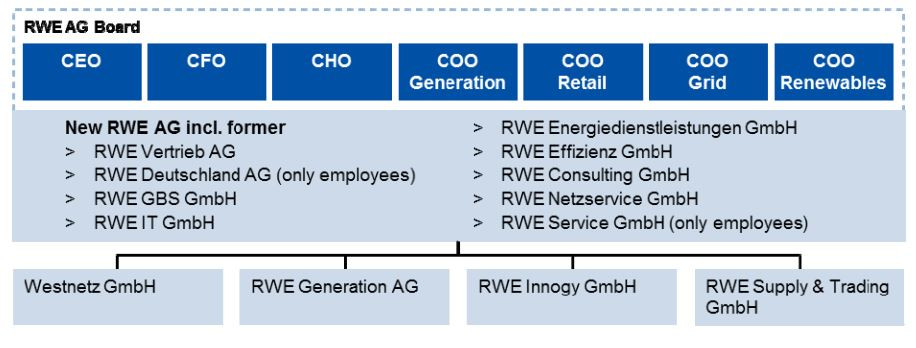RWE unveils turnaround plan
German utility RWE has announced a comprehensive reform of its management and company structure, in reaction to the “massive transformation of the energy market in recent years”.
In order to face the “major challenges” of the shift to a renewable power supply and the phase-out of nuclear energy (the Energiewende), Germany's second-largest energy provider will pool together several of its operations under the banner of RWE AG, formerly its holding company.
Subsidiaries such as RWE Group Business Services, RWE IT, RWE Effizienz, RWE Service and RWE Vertrieb (sales and distribution) will all form part of a new operating company (see chart).
In addition, seven out of ten supervisory board committees of the merged German subsidiaries and 30 out of 90 limited liability companies will cease to exist. The functional management of the different business areas that will become part of the “one RWE” will instead lie with the Chief Operating Officers (COO) in the RWE AG management team, creating seven top management posts instead of the current eight.
“These changes are further milestones on the path towards making RWE fit for the new energy world and to becoming one RWE,” CEO Peter Terium said after the supervisory board had unanimously given its okay in an extraordinary meeting on Monday.
But he also acknowledged that the move was in response to tough times at the company. “RWE is sailing in difficult waters, we can’t influence politics and the markets but we can influence our own capability of steering in them,” he said.
The reorganisation would not save big amounts of money, Terium admitted, adding that the figure was within a double-digit million amount. Concrete personnel decisions were still to come, but the board decision did not include any job cuts, he added. All of the announced changes will be implemented by 1 January 2017.
“RWE – like all large German energy companies – is under a lot of pressure,” says Heinz-Josef Bontrup, professor of applied economics at the Westphalian University of Applied Sciences. The company had proved pretty helpless when trying to adapt to the changes in the energy sector on the market side for example by investing in renewable energies, he told Clean Energy Wire. The company therefore now needed to take action on costs and streamline its management.
Split is an option but not desirable
RWE’s restructuring exercise comes not long after larger rival E.ON announced in December that it would split its operations, creating a new company called Uniper that would focus on fossil and nuclear power while the E.ON brand would be used for work on (smart) grids and renewables.
In today’s announcement RWE steered clear of announcing a similar path, stressing several times that it was forming “one” RWE AG from many of its subsidiaries – the opposite of a split.
However, RWE Generation SE/RWE Power AG (fossil generation and nuclear power), RWE Innogy (renewables) and RWE Supply&Trading are not part of the merger.
Mr. Terium said that RWE was not planning a spin-off of its conventional power generation business as E.ON did, even though the new structure would keep this option open. “But I don’t think this is a desirable option.”
RWE’s position as a baseload provider of conventional electricity also had a strong future in the new energy world, he added, unless political and market conditions forced the company to change its strategy.
RWE sees potential for growth of its renewable business mainly in the onshore and offshore wind sector and has been looking into investment in countries with favourable regulatory conditions, such as Germany, the UK, the Netherlands and some eastern European states, Mr. Terium said.
More details of the RWE reorganisation here.
See a CLEW factsheet on Germany's utilities and the Energiewende here.


